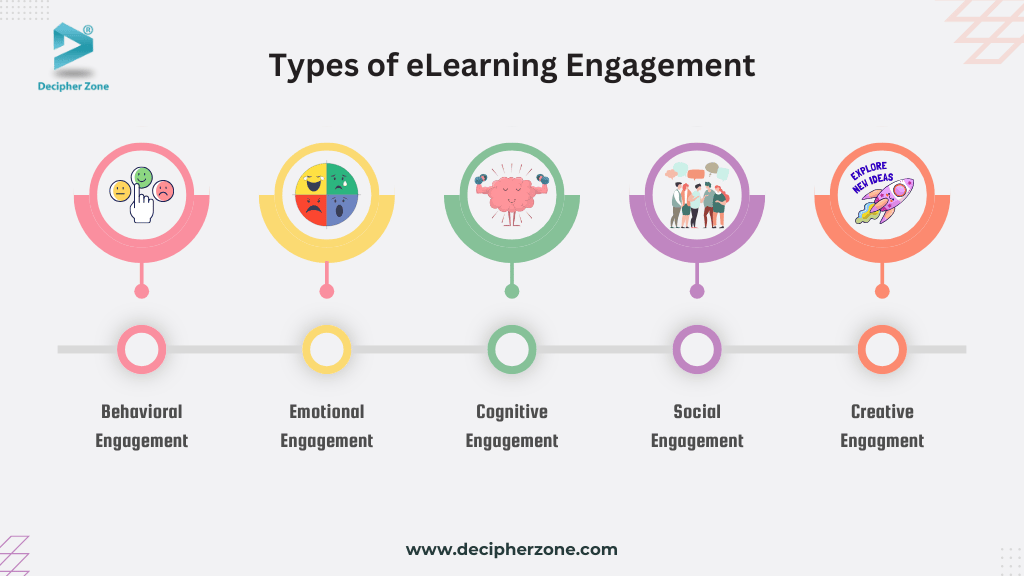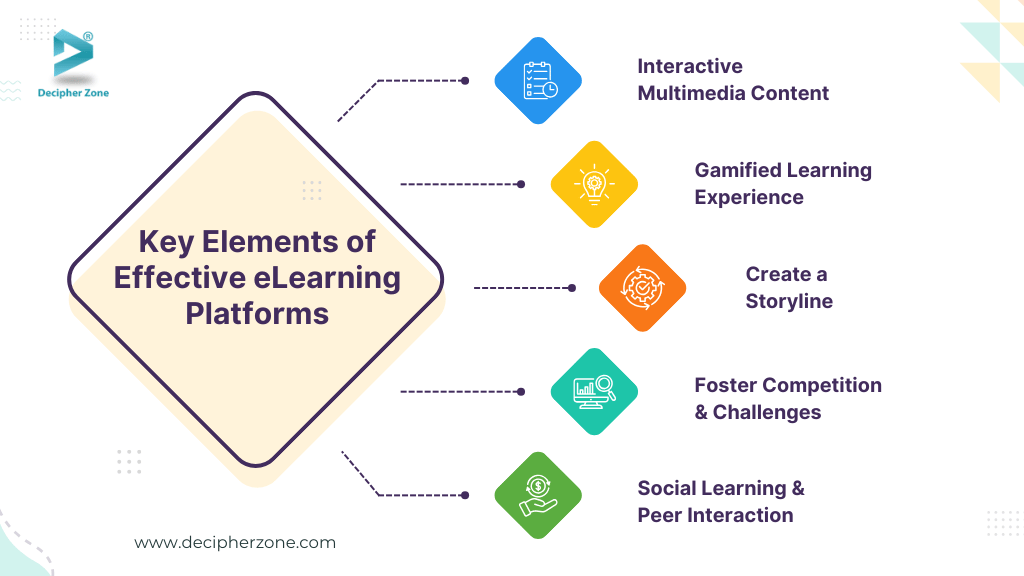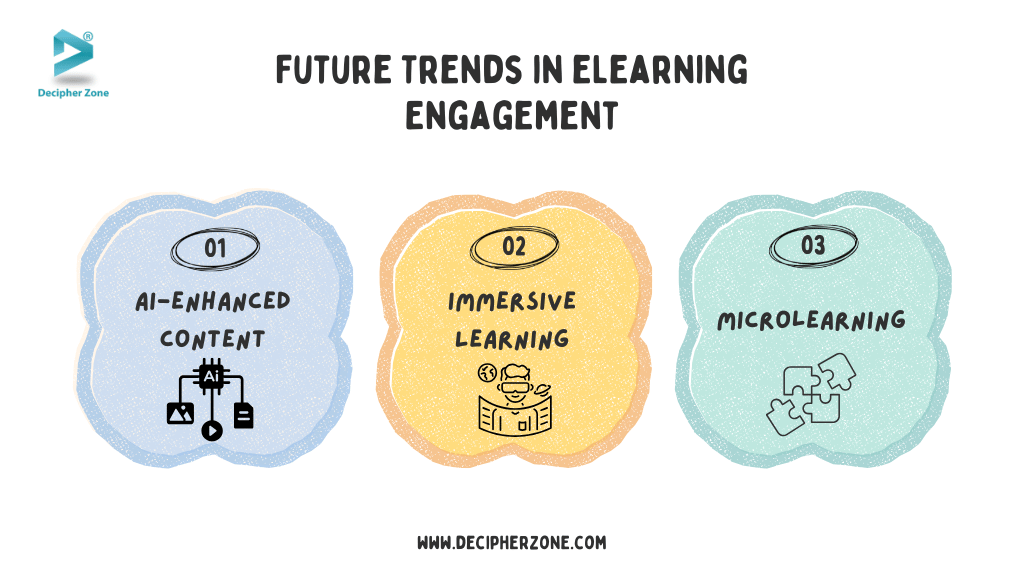This blog will cover the importance of learner engagement in an eLearning platform. We will delve into the essential engagement metrics, key elements, types of eLearning platforms, engaging features, and the role of data analytics in boosting engagement. We will also look into future trends and the cost of developing a learning platform that makes a difference.
Do you assume that eLearning is just “click, watch, repeat”? Think again. Building an eLearning platform is more like directing and creating a blockbuster movie. It needs plot twists, actions, and a “can’t-look-away factor” to really keep the learners engaged.
In the fast-paced world of technology and tons of distracting platforms, if your eLearning platform is snooze-fest, it’s only a matter of time before the learner starts ghosting. To make things easier and guarantee the success of your eLearning platform, we will share features, metrics, and strategies to adapt during software development to boost learner engagement.
What you’ll walk away with:
-
What is eLearning software?
-
Why do eLearning providers need to prioritize engagement?
-
What are the key engagement metrics to consider in eLearning?
-
What are the different types of engagement?
-
How does high engagement impact learning outcomes?
-
What are the key elements of effective eLearning platforms?
-
What types of eLearning software platforms are available, and how do they impact engagement?
-
How do virtual classrooms and conferencing tools affect learner engagement?
-
What innovative engagement features can be found in eLearning platforms?
-
How does gamification enhance engagement in eLearning?
-
In what ways does interactive multimedia content promote engagement?
-
How does AI-driven personalized learning create a better engagement experience?
-
What is the role of social learning and peer interaction in enhancing engagement?
-
How can data and analytics help in the continuous improvement of learner engagement?
-
What are the costs associated with developing a learner engagement platform?
-
What are the future trends in eLearning engagement?
Defining eLearning Software Platform
eLearning software is the one-stop solution for learners to gain knowledge about different subject matters, minus the awkward co-students, heavy textbooks, and uncomfortable chairs. This software is designed with the sole purpose of providing virtual learning content for diverse learners such as school/college students, office employees, customers, partners, etc.
It allows them to learn about different concepts and products online from anywhere at any time through PCs or mobile devices with ease. eLearning software is more than just online content, it is the backbone of interactive, engaging learning experiences that adapt to the pace of the learner.
However, most of the time, eLearning providers overlook the importance of making the content as engaging as it needs to retain learners, as their primary focus shifts to generating revenue rather than delivering high-quality content. (We’ll discuss how to avoid this pitfall later).
But first, let’s understand…
Why do eLearning Providers need to Prioritize Engagement?
Have you seen traditional classrooms where students are half-listening, doodling on their notebooks, or glancing out of the window instead of actively participating? This challenge can be a major pitfall for eLearning platforms too if they fail to capture learners' attention. For those who don’t want to fall under the same trap, it's essential to prioritize learner engagement through innovative strategies and interactive methods.
Why is maximizing learner engagement in your platform important? Engaged learners tend to achieve greater success in eLearning. When learners are actively involved, they are more likely to retain information, comprehend the material better, and ultimately realize more effective learning outcomes. This heightened engagement can significantly boost your business revenue.
Learners who stay engaged are not only more likely to complete courses but also to remember what they’ve learned and achieve superior results. Furthermore, the increased satisfaction from engaged users can lead to higher retention rates, which in turn contributes to more revenue for your platform.
Types of eLearning Software Platforms
Now that we know what eLearning software is and why is it important to prioritize engagement in the platform, let’s understand the different types of eLearning platforms that you can go for:

-
Learning Management Systems (LMS): LMS are designed to deliver, track, and manage educational courses and corporate training programs. These platforms come with assessment tools to keep track of learner’s progress.
-
Learning Content Management Systems (LCMS): Apart from what LMS can do, LCMS also helps create, store, and manage content. It also comes with authoring tools that make content creation efficient.
-
Learning Experience Platforms (LXP): These are learner-centric platforms that are infamous for delivering personalized learning experiences using artificial intelligence that recommends engaging content. LXPs also support flexible and social learning.
-
Training Experience Platforms (TXP): While it’s somewhat similar to LXP, it is more concentrated on corporate training. TXPs deliver custom learning paths while emphasizing practical training for skill development, certifications, and upskilling.
-
Learning Record Stores (LRS): LRS are specifically designed to store learning records from different sources using APIs, which means these platforms can track a wide range of learning activities of the users with or without an active internet connection.
Understanding Engagement Metrics in eLearning
Measuring learner engagement on an eLearning platform is more complex than simply counting likes on social media. We’re talking about a fine mix of factors that dive deep into interactions, behaviors, attention spans, and completion rates.

These metrics are your best friends when it comes to assessing course effectiveness and understanding how invested learners truly are. So, what should you be keeping an eye on? Here are some key metrics to monitor:
-
Average Session Length: This metric indicates the amount of time learners spend engaging with the content, providing insights into their level of interest and involvement.
-
Completion & Drop-Out Rates: Analyzing the number of students who finish a course versus those who discontinue can reveal critical insights into course effectiveness and learner retention.
-
Interactions Frequency: This aspect examines how often learners engage with interactive elements such as embedded questions, simulations, and branching scenarios, highlighting the levels of engagement within the course.
-
Feedback Score: Gathering user feedback, including their experiences and any issues encountered on the platform, is essential for enhancing the overall learning experience.
-
Performance Outcomes: These indicators serve as crucial metrics for evaluating the eLearning platform's effectiveness. They reflect user engagement and success, with scores and grades helping to identify both performance levels and areas that may require further attention.
Types of Engagement for eLearning Platforms
Learner engagement is not solely measured by attendance; it's more about the quality of that engagement. Think of it as the difference between a casual observer and a fully invested participant.

It can be classified into various types, each illustrating how learners interact with the platform, the content, and one another. Below, we have outlined the primary types of engagement, along with some additional ones that significantly enhance the creation of dynamic eLearning experiences.
1. Behavioral Engagement
Behavioral engagement serves as the foundation of the learning process and encompasses the actions that learners take on the platform. It provides insight into whether students are actively following instructions, completing tasks, and demonstrating a commitment to finishing the course.
To put it simply, this engagement can be easily measured through consistent logins, active participation in discussions, completion of assignments, and seamless navigation through various learning modules.
2. Emotional Engagement
It refers to the attitude and feeling of the learner towards the platform, course, and learning process. Are they motivated, enthusiastic, and enjoy what they’re learning? Learners who are emotionally engaged are more likely to have a positive mindset and willingness to deepen their understanding and explore new topics.
3. Cognitive Engagement
Learners' curiosity and interest in the course material, along with their ability to process information, make connections, and engage in critical thinking, are crucial for achieving cognitive engagement. When learners are actively involved with the content, they tend to understand and apply the information in meaningful ways, which ultimately enhances retention and enables them to use their knowledge effectively in real-world situations.
4. Social Engagement
This approach to learner engagement highlights the importance of collaboration, interaction, and peer connections, which can be especially beneficial in online learning environments where isolation is often a significant challenge. Social engagement fosters a sense of community, making learners feel they are part of a shared experience, which in turn boosts their motivation and accountability.
5. Creative Engagement
Creative engagement emphasizes the desire of the learner to explore, create, and express unique ideas. This type of engagement uses artistic experiences to encourage learners to go above and beyond structured assignments to build something original.
The Impact of High Engagement on Learning Outcomes
When it comes to eLearning, learner engagement is the name of the game. Let’s be real: if learners aren’t actively participating, they might as well be watching paint dry. But when they dive in—joining discussions, collaborating on tasks, or tackling interactive activities—the magic happens. Not only do they enjoy the learning process way more, but they also grasp the material better and hang onto that knowledge like it’s their favorite playlist.
Think of engagement as the secret flavoring that transforms a mundane online course into an electrifying experience. When learners feel that spark—whether through lively chats or hands-on tasks—they forge a genuine connection with the subject matter. And that connection? It’s the ticket to success!
Key Elements of Effective eLearning Platforms
An effective learning platform isn’t just a glorified digital library, it is a vibrant ecosystem that has been designed to inspire, engage, and keep learners coming back for more. We have enlisted the core elements of eLearning platforms that you can consider implementing to boost the learner’s retention and outcomes.

-
Interactive Multimedia Content: To cater different learning styles of the users, it makes sense to incorporate interactive multimedia elements like animations, quizzes, and videos in the platform to improve information retention among learners.
-
Gamified Learning Experience: eLearning platforms are increasingly incorporating gaming elements, such as badges, leaderboards, and points, to keep learners motivated and make learning enjoyable, which significantly enhances the likelihood of course completion.
-
Create a Storyline: You can also develop a cohesive narrative throughout the course to create emotional connection and context among learners, making content more memorable and relatable.
-
Foster Competition & Challenges: Integrate challenges and competitions into the platform to encourage healthy competition among peer learners. This approach not only enhances engagement but also strengthens the sense of community. Additionally, recognizing learners' achievements with rewards and shout-outs can promote a feeling of accomplishment, motivating ongoing participation.
-
Social Learning and Peer Interaction: Add a forum in the eLearning platform through which users can collaborate, discuss, share insights, and support each other, enriching their educational experience.
How Data Analytics Help in Continuous Engagement Improvement in eLearning
Data analytics has become an essential component of the rapidly evolving eLearning industry, where new technologies are continually reshaping the learner experience. It is not just a passing trend; it represents a comprehensive approach to developing data-driven strategies that deliver personalized and exceptional learning experiences.
By implementing data analytics within eLearning platforms, administrators can assess various metrics for future enhancements. These metrics include assessment data, behavioral analytics, engagement data, performance analysis, and feedback evaluation, among others. Analyzing learner data allows administrators to identify common drop-off points, recognize popular content, and tailor learning paths, ensuring that the platform remains relevant and engaging for all users over time.
Costs of Developing an eLearning Platform that Boosts Engagement
Developing a fully featured, engaging eLearning platform can cost anywhere from $15,000 to $200,000, depending on the wireframing, prototyping, interactive features, design intricacies, platform type, customization needs, platform complexity, technical stack, user authentication, mobile responsiveness, development time, course creation options, video hosting, bandwidth, security, compliance, maintenance, updates, and resources.
Future Trends in eLearning Engagement
The future of eLearning is poised to embrace a range of innovative approaches designed to enhance learner engagement and overall experience. Here are some key trends shaping this evolution:

1. AI-Enhanced Content
By implementing AI in the eLearning platforms, administrators will be able to analyze learners’ data to deliver personalized recommendations and tailored content that make sure each user receives material suitable for their unique learning style and needs.
2. Immersive Learning
In the coming years, we can expect a significant surge in the adoption of augmented and virtual reality technologies within eLearning platforms. The integration of AR and VR will create immersive experiences that allow learners to engage dynamically with content, making it easier to grasp complex subjects that were previously challenging.
3. Microlearning
Indulging microlearning in eLearning will enable ed-providers to deliver bite-sized content that addresses specific skills or knowledge areas. This approach lets learners access information quickly and efficiently, making it ideal for just-in-time training in fast-paced environments.
Conclusion
In a digital environment, where distractions are just a click away, cultivating a sense of connection and interaction can make all the difference. Prioritizing learner engagement not only enhances the educational experience but also ensures the success of your eLearning platform in a competitive market.
By investing in a dynamic engagement-driven eLearning platform, you as a business, can make a lasting impact on the learners, keeping them motivated, engaged, and progressive in acquiring new languages or skills — all while ensuring the learning experience remains enjoyable.
So, what are you waiting for? Get in touch with the expert team of Decipher Zone and get a personalized quote for developing a robust, secure, and engaging eLearning platform today!

FAQs
-
What’s the need to prioritize learner engagement in eLearning?
Engaged learners tend to achieve greater success in eLearning. When learners are actively involved, they are more likely to retain information, comprehend the material better, and ultimately realize more effective learning outcomes. This heightened engagement can significantly boost your business revenue.
-
What are the most crucial features that help increase learner engagement in eLearning?
It’s tough to choose just one, but a blend of personalized learning paths, storylines, interactive multimedia, and gaming features can drastically improve engagement on the eLearning platform.
-
How to track learner engagement on the eLearning platform?
Using metrics like assessment scores, average session length, completion & drop-out rates, interaction frequency, feedback score, and performance outcomes can help gauge the engagement level of the learners to make informed improvements.

